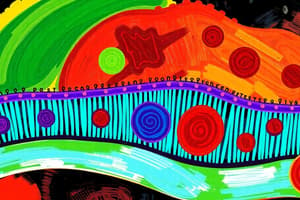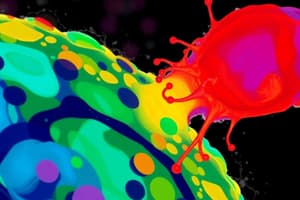Podcast
Questions and Answers
What is the primary characteristic that allows some materials to pass through the plasma membrane while restricting others?
What is the primary characteristic that allows some materials to pass through the plasma membrane while restricting others?
- Characteristics of the material and the membrane (correct)
- Temperature of the environment
- Shape of the cell
- Nature of the solvent
Which type of transport mechanism requires ATP to move substances across the plasma membrane?
Which type of transport mechanism requires ATP to move substances across the plasma membrane?
- Osmosis
- Active transport (correct)
- Simple diffusion
- Facilitated diffusion
What process describes the movement of water across a membrane to equalize solute concentrations?
What process describes the movement of water across a membrane to equalize solute concentrations?
- Osmosis (correct)
- Diffusion
- Endocytosis
- Exocytosis
In what stage of the cell cycle does mitosis occur?
In what stage of the cell cycle does mitosis occur?
Which type of vesicular transport is responsible for the uptake of large particles or other cells?
Which type of vesicular transport is responsible for the uptake of large particles or other cells?
Which organelle is responsible for protein synthesis within the cell?
Which organelle is responsible for protein synthesis within the cell?
What structure separates the intracellular environment from the extracellular space?
What structure separates the intracellular environment from the extracellular space?
During which phase of the cell cycle does DNA replication occur?
During which phase of the cell cycle does DNA replication occur?
Which type of organelle is characterized by being completely enclosed by membranes?
Which type of organelle is characterized by being completely enclosed by membranes?
What is the main function of the Golgi apparatus in a cell?
What is the main function of the Golgi apparatus in a cell?
What is the main function of the glycocalyx in a cell?
What is the main function of the glycocalyx in a cell?
Which type of ribosome is responsible for synthesizing proteins for export out of the cell?
Which type of ribosome is responsible for synthesizing proteins for export out of the cell?
What role do kinesin and dynein play in the cell?
What role do kinesin and dynein play in the cell?
Which cellular structure is directly involved in the process of transcription?
Which cellular structure is directly involved in the process of transcription?
What happens during the process of translation?
What happens during the process of translation?
What is one function of the cytoskeleton in a cell?
What is one function of the cytoskeleton in a cell?
Which component is responsible for the 'stiffening' of the plasma membrane?
Which component is responsible for the 'stiffening' of the plasma membrane?
What is the primary function of centrioles in a cell?
What is the primary function of centrioles in a cell?
During what part of the cell cycle do cells spend a majority of their time?
During what part of the cell cycle do cells spend a majority of their time?
Which structure is NOT covered by a membrane?
Which structure is NOT covered by a membrane?
Flashcards
Phospholipid bilayer
Phospholipid bilayer
The plasma membrane's structure, composed of two layers of phospholipids with hydrophilic heads facing outwards and hydrophobic tails inwards.
Integral proteins
Integral proteins
Proteins permanently embedded within the plasma membrane, often spanning the entire membrane.
Peripheral proteins
Peripheral proteins
Proteins temporarily attached to the membrane's inner or outer surface, often involved in cell regulation or enzyme activity.
Glycocalyx
Glycocalyx
Signup and view all the flashcards
Cytoskeleton
Cytoskeleton
Signup and view all the flashcards
Centrioles
Centrioles
Signup and view all the flashcards
Ribosomes
Ribosomes
Signup and view all the flashcards
Free ribosomes
Free ribosomes
Signup and view all the flashcards
Bound ribosomes
Bound ribosomes
Signup and view all the flashcards
Transcription
Transcription
Signup and view all the flashcards
Cell Theory
Cell Theory
Signup and view all the flashcards
Cellular Organelles
Cellular Organelles
Signup and view all the flashcards
Plasma Membrane
Plasma Membrane
Signup and view all the flashcards
Cytoplasm
Cytoplasm
Signup and view all the flashcards
Cellular Differentiation
Cellular Differentiation
Signup and view all the flashcards
Diffusion
Diffusion
Signup and view all the flashcards
Osmosis
Osmosis
Signup and view all the flashcards
Passive Transport
Passive Transport
Signup and view all the flashcards
Active Transport
Active Transport
Signup and view all the flashcards
Study Notes
Cell Theory
- Cells are the fundamental units of all living things
- All living organisms are composed of cells
- All cells arise from pre-existing cells
Cellular Organelles
- Organelles are "little organs" within cells, performing specific tasks
- Non-membranous organelles: Not enclosed by membranes, in direct contact with cytosol -Cytoskeleton -Microfilaments -Intermediate filaments -Microtubules -Cilia -Microvilli -Flagella -Centrioles -Ribosomes
- Membranous organelles: Enclosed by membranes, isolated from cytosol -Mitochondria -Endoplasmic Reticulum (ER) -Rough ER -Smooth ER -Golgi Apparatus -Lysosomes -Peroxisomes -Nucleus
Levels of Organization
- Chemical Level: Atoms combined to form molecules
- Cellular Level: Cells are the fundamental units of life
- Tissue Level: Groups of similar cells working together
- Organ Level: Different tissues combine to form organs
- Organ System Level: Organs working together as a system
- Organism Level: Multiple organ systems interacting to form a complete organism
Introduction to Cells
- Cells are the smallest units considered living
- Typical cell size is approximately 0.1 mm in diameter
- Cell functions depend on underlying chemistry of their parts, including membranes, organelles and protein production processes
Cellular Differentiation
- Cellular differentiation: The process where generalized cells develop into specialized cells with specific functions
- A fertilized ovum (zygote) holds the genetic potential to develop into any cell type in the body
- Through cell division and differentiation, the zygote gives rise to various specialized cell types
Cellular A&P
- Cells provide different compartments, enabling storage, transport, and other functions
- The human body is approximately two-thirds water
- Cells distribute water and dissolved substances within/around the body
- Plasma Membrane: A layer separating the inside and outside of a cell
- Cytoplasm: The internal content of the cell
- Intracellular Fluid: The fluid inside the cell (cytosol)
- Extracellular Fluid: The fluid outside the cell
Cell - Plasma Membrane
- Composed of: -Phospholipid bilayer -Cholesterol -Proteins -Integral -Transmembrane -Peripheral -Glycocalyx (a carbohydrate layer outside cells)
- Phospholipid bilayer:
- Measures 6-10 nm
- Two layers of phospholipids
- Hydrophilic heads face outside
- Hydrophobic tails face inside
- Phospholipids interspersed with cholesterol molecules
- Functions as a plasma membrane stiffener
- Proteins
- Integral proteins: Permanently attached, often span the cell membrane and can transport water or solutes
- Peripheral proteins: Temporarily attached to inner or outer membrane surfaces
- Glycocalyx is a carbohydrate layer. Attached to proteins or lipids, functions in cell recognition, binding to extracellular structures, and lubrication
Cell - Cytoskeleton
- No membrane
- Functions include: internal framework, transportation highway
- Components: Proteins -Microfilaments -Intermediate filaments -Microtubules -Kinesin & Dynein movement on microtubules
- Centrioles:
- No membrane
- Composed of microtubules
- 2 centrioles form a centrosome
- Control DNA movement during cell division
- Ribosomes
- No membrane
- Made of ribosomal RNA & protein
- Responsible for protein synthesis
- Two classifications -Free Ribosomes (Found throughout the cytoplasm, make proteins that stay in the cytosol) -Fixed/Bound Ribosomes (Attached to the rough endoplasmic reticulum, make proteins to be exported out of the cell)
Cell - ER
- Endoplasmic Reticulum (ER)
- Network of sacs and tubules in the cytoplasm
- Cisternae (sacs and tubules) are continuous with the nuclear envelope
- Fixed ribosomes are attached to rough ER
Cell - Golgi Apparatus
- Involved in modifying, sorting and packaging proteins for secretion or use within the cell
- Incoming transport vesicles deliver materials to the cis face (receiving side)
- Materials pass through the cisternae
- Vesicles eventually bud off from trans face (shipping side) to deliver processed materials
Cell - Lysosomes
- Vesicles containing enzymes that break down waste materials and cellular debris
- Enzymes function inside lysosomes so they don't cause harm elsewhere
- Extracellular material can be brought into the cell via vesicles/endocytosis.
- Digest parts of cells and cellular debris.
Cell - Mitochondria
- Double membrane organelles responsible for cellular respiration, where energy (ATP) is produced
- Cristae are folds of the inner membrane
- Matrix is the area inside the inner membrane
- Contains enzymes for respiration
Cell - Nucleus
- Control center of the cell
- Contains DNA and regulates gene expression
- Nuclear Envelope: Double membrane surrounding nucleus
- Nuclear Pores: Allow exchange of material between nucleus and cytoplasm
- Nucleolus: Structure within nucleus involved in ribosome production
- Nucleoplasm: The fluid inside the nucleus
Cell - DNA
- Stored in the nucleus of eukaryotes
- Instructions for RNA and protein synthesis
- One human cell's DNA is approximately 2 meters in length
- Double Helix
- Nucleosomes
- Chromatin
- Chromosome
Transcription & Translation
- DNA: instructions for building proteins
- Transcription: DNA to RNA process
- Translation: (mRNA) to protein process
DNA - Gene
- Functional unit of heredity, determines a characteristic
- Contains ~300-3000 nucleotides
DNA - Transcription
- Producing an RNA complement from a given gene (mRNA, messenger RNA): the process of making a copy of a DNA sequence into a complementary RNA sequence
- DNA sequence is used as a template to produce a complementary RNA molecule
DNA - Translation
- Using the mRNA sequence to create a protein
- mRNA sequence is used as a code to assemble amino acids in a specific order, creating a protein
- Happens in the ribosome
Membrane Transport
- Plasma membrane is selectively permeable
- Characteristics of material to pass: size, shape, lipid solubility, electrical charge.
- Characteristics of cell membrane: What lipids/proteins are present, how they’re arranged.
- Diffusion: Movement of materials from an area of high concentration to low concentration.
- Osmosis: Movement of water across a selectively permeable membrane from a region of high water concentration to low water concentration.
- Tonicity:
- Isotonic Solution: Solute concentrations are equal inside and outside the cell, water movement is balanced
- Hypotonic solution: Solute concentration is lower outside the cell than inside the cell; water moves into the cell; cell swells and can burst if too much water enters [lysis]
- Hypertonic solution: Solute concentration is higher outside the cell than inside the cell; water moves out of the cell; cell shrinks and shrivels [crenation]
- Passive Transport:
- Simple Diffusion: Movement of small, nonpolar molecules directly through the phospholipid bilayer
- Facilitated Diffusion: Transport of larger or charged molecules via membrane proteins (carrier proteins or channels)
- Active Transport: Requires energy (ATP) to move molecules against their concentration gradient.
- Carrier-mediated transport: Transport of larger molecules via membrane proteins
- Vesicular transport: Materials move in or out of the cell enclosed in vesicles (Endocytosis/Exocytosis)
Cell Cycle
- Mitosis: Somatic cells divide to create two identical cells.
- Function: Growth, repair, and asexual reproduction
- Stages: Interphase, mitosis, cytokinesis
- Meiosis: Sex cells divide to create four genetically unique cells (gametes).
- Function: Sexual reproduction
- Stages: Interphase, meiosis 1, meiosis 2
Cancer
- If DNA is damaged or mutates, stop & go signals for cell division can be altered
- Tumor: Uncontrolled cell division
- Cancer: Uncontrolled, harmful cell division
- Cancerous cells compete with normal cells for resources
- Benign tumor: Non-cancerous cells remain within original tissue, seldom a threat
- Malignant tumor: Cancerous, invades surrounding tissue, disrupts function, and stimulates blood vessel growth (angiogenesis)
- Metastasis: Cells migrate to other areas and establish new tumors
Studying That Suits You
Use AI to generate personalized quizzes and flashcards to suit your learning preferences.




